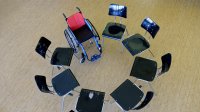How to Introduce Lessons on Disability
Disability should have a place in schools’ anti-bias work along with race, gender, sexual orientation, and religion.
Your content has been saved!
Go to My Saved Content.In Illinois, where I work as a fourth-grade teacher, two new state plans will make it critical that schools select thoughtfully curated social and emotional learning (SEL) curricula that are culturally responsive and designed to serve marginalized students. Most of us know that identities such as race, ethnicity, gender, sexual identity, nationality, and religion are crucial aspects of this work. And they are, full stop. Yet there’s one area that often gets overlooked in these conversations: disability.
As we begin the 2021–22 school year with a renewed focus on identity studies and anti-bias instruction, we must look to broaden our lens of intersectionality to incorporate disability.
4 Ways to Add Disability to Your Anti-bias Work
1. Take a broad student-led, student-centered approach. Though disability is all around us, many of us do not have experience discussing it. Disabilities often go unmentioned because people are afraid of saying the wrong thing or may not realize the true spectrum of disability, given that many disabilities are invisible.
Ensuring that your students have language to acknowledge the truly wide spectrum of diversity, including disability, is a strong first step. I have found that, once given the opportunity to discuss disability within the broader context of identity, my students have plenty to offer. I begin these conversations by presenting a story, book, news article, or short video that opens the door to discussing disability.
From there, rather than being the sole driver of conversation, I spend time listening to the thoughts, questions, and observations of my students. Taking a facilitation role allows students to begin to make sense of disability based upon their own world viewpoint and can be rather powerful in beginning your own anti-bias instruction journey.
2. Utilize disability as your springboard for discussion. I will admit that I found it challenging, at first, to find ways to connect the dots between disability and all other marginalized communities. Most of my own reading and professional development in the anti-bias realm has centered on race, ethnicity, and gender. It was not until I was hired to support anti-ableism programs by The Nora Project (TNP), a nonprofit that promotes disability inclusion, that I was able to see the true connection. It became even clearer to me that many of the struggles of stereotypes, prejudice, and discrimination are shared by all marginalized groups, including the disabled. By working toward the liberation of one marginalized community, I could work toward the liberation of many others, too. Indeed, this is the underlying premise of the disability justice movement.
The curriculum writing I did for TNP used lessons about demystifying disability as a springboard for a broader conversation about the human condition, diversity, and how identities, power, and marginalization intersect. So now, instead of leading with a discussion about race or gender, I am able to begin my classroom conversations by discussing disability discrimination, which allows me to tie and layer that into other forms of discrimination. Because one in five Americans is disabled, and because most people will experience disability in their lifetimes, it’s a natural jumping-off point for these complex discussions.
3. Focus on building a strong classroom community. With all of the unknowns of our upcoming school year, the idea of creating a strong classroom community is even more important to ensure that students feel comfortable and at home within the classroom. Begin by establishing cocreated community agreements. This will allow students to build an environment where they feel comfortable sharing their thoughts and beliefs.
My class’s community agreements tend to center on respectful listening, turn-taking while sharing opinions and observations, respecting each other’s thoughts, and knowing that, while we will make mistakes when learning about new topics, we aim to learn and grow from those mistakes. I have found that, when discussing disability, students may be engaging in their first conversation about the topic, which only further underscores the need for a strong classroom community.
4. Choose a strong curriculum partner. Lastly, as educators, schools, and districts look to incorporate anti-bias instruction into their work, it’s also important to know that this does not have to be a solo venture. Selecting a strong curriculum partner that looks to center the voices of the people who have lived experience can make a world of difference. I have found that having the right resources to fall back on when deeply engaging in this work has been invaluable. Looking for organizations and curricula that value intersectionality is a large part of the battle to ensure that disability has a seat at the anti-bias table.
As summer approaches, and educators look to prepare themselves for the upcoming school year, the stage is set for schools to bring identity studies into the classroom. With new laws and Covid-related funding, the biggest obstacle—money—is no longer an excuse to stall this progress. We need to support our future leaders, our students, in building a more inclusive world: one that allows disability to be a part of this broader discussion.
